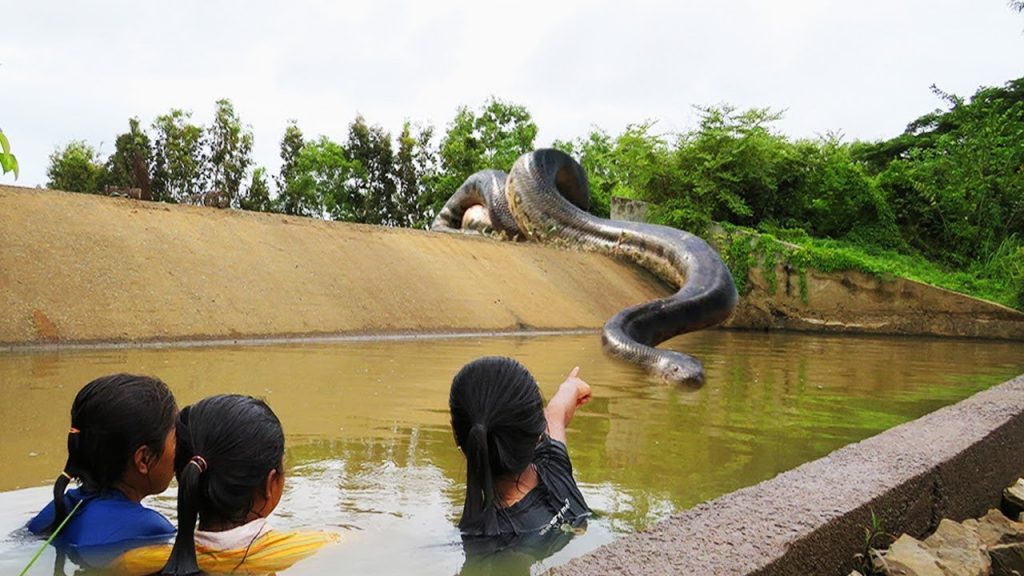A 100-meter-long giant bull-headed snake has scared residents of Kalimantan, India. The large snake was first spotted in a nearby river and quickly became the taƖk of the town.
Local residents have reported seeing the creature croaking along the riverbank, with its massive bull-head in an alert position. Wildlife experts have warned residents to stay away from the animals as they could be dangerous and aggressive.

Scientists are investigating the origin of the giant snake, with some speculating that it could be the result of a genetic experiment. However, others believe the creator is simply a legend or a folk myth.
Meanwhile, residents of KalimanTɑn are taking extra precautions to stay safe, including riding horses and putting fences around the river to prevent the giant snake from approaching the town.
The giant bull-headed snake has created much speculation and mystery in the city, and is likely to continue to be a topic of discussion for some time to come

The largest living snakes in the world, measured by length or by weight, are various members of the families Boidae and Pythonidae. They include anacondas, pythons, and boa constrictors, which are all nonvenomous constrictors. The longest venomous snake, at up to 5.6 to 5.7 m (18.5 to 18.8 ft) in length, is the king cobra,[1] and the heaviest venomous snake is likely to be the Gaboon viper (which also has the longest fangs and delivers the most venom) or possibly the eastern diamondback rattlesnake – all three reaching maximum weights in the 6 to 20 kg (13 to 44 lb) range.
There are fourteen living snake species with a maximum mass of at least 50 lb (23 kg), as shown in the table below. This includes all species that reach a length of at least 20 ft (6.1 m). There are two other species that reach nearly this length: the Oenpelli python (binomial name Nyctophilopython oenpelliensis, Simalia oenpelliensis, or Morelia oenpelliensis),[2] and the olive python (Liasis olivaceus). Available information on these two species is quite limited.[3] The Oenpelli python, in particular, has been called the rarest python in the world.[4][5][6] By weight, the blood python (Python brongersmai) is also a relatively massive snake, although it does not reach exceptional lengths.
It is important to note that there is considerable variation in the reported maximum size of these species, and most measurements are not truly verifiable, so the listed sizes should not be considered definitive. In general, reported lengths are likely to be somewhat overestimated. [7] Despite what has been, for many years, a standing offer of a large financial reward (initially $1,000 offered by U.S. President Theodore Roosevelt in the early 1900s,[8] later increased to $5,000, then $15,000 in 1978, and $50,000 in 1980) for a live, healthy snake over 30 feet (9.14 m) long by the New York Zoological Society (later renamed the Wildlife Conservation Society), no attempt has ever been made to claim the reward. [3]
Although the reticulated python is generally accepted to be the world’s longest snake, most length estimates of over 6 m (20 ft) have been questioned. [7] It has been suggested that reliable length records for larger snakes should be established from a carcass shortly after death, or alternatively from a heavily sedated snake, using a steel tape and in the presence of witnesses, and should be published (and preferably videotaped). [7] At least one reticulated python was measured under full anesthesia at 6.95 m (22.8 ft), and somewhat less reliable scientific reports up to 10 m (33 ft) have appeared. [9]
Although weight is easier to measure reliably than length (e.g., by simply measuring the weight of a container with and without the snake inside and subtracting one measurement from the other), a significant factor in a snake’s weight is whether it has been kept in captivity and provided with an unusual abundance of food under conditions that also cause reduced activity levels. In addition, the weight of wild specimens is often reduced as a symptom of parasitic infestations that are eliminated by veterinary care in captivity. Therefore, the largest weights measured for captive specimens often far exceed the largest weights observed in the wild for the same species. This phenomenon may particularly affect weight measurements for anaconda species that are kept in captivity.





